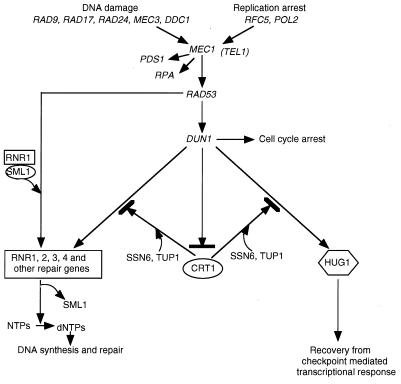FIG. 7.
HUG1 is a critical component of the checkpoint response. Signals received from the sensors for DNA damage and replication arrest are transduced through the kinases MEC1 and TEL1, leading to phosphorylation and activation of RAD53 and DUN1, causing cell cycle arrest and transcriptional induction, which can be DUN1 independent or dependent (12). SML1 (46) and CRT1 (16) function to negatively regulate the MEC1 effectors RNR1 and RNR1 to 4, respectively. Transcription of HUG1 is induced in response to replication arrest and DNA damage in a checkpoint-dependent manner. Deletion of HUG1 rescues the lethality of mec1Δ and the HU sensitivity of dun1Δ strains; overexpression of HUG1 is lethal in combination with a mec1 mutation in the presence of replication arrest or DNA damage. These observations, along with the delayed induction of HUG1 in response to HU, suggest that HUG1 may function, in part, through the negative regulation of MEC1 effectors, perhaps facilitating recovery from the transcriptional response after DNA damage and replication arrest.

